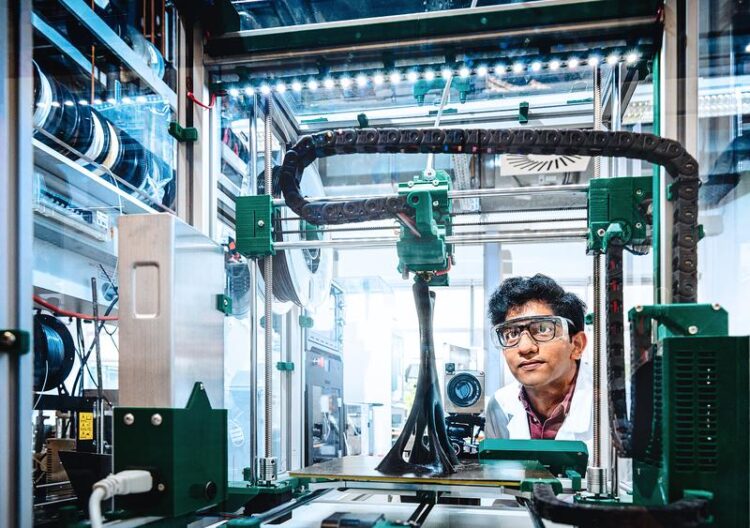4D printing: heat shrinks printed objects

Dilip Chalissery develops the process technology for 4D printing at Fraunhofer IAP.
Bild: sevens+maltry photographers / Potsdam Science Park
Printed polymers that change shape once in a predefined way when heated? This is now possible thanks to a 4D printing technology developed in the Fraunhofer Cluster of Excellence Programmable Materials CPM. The extent of the change in shape of the printed objects is drastic: they can shrink by up to 63 percent. In the future, 4D manufacturing technologies could be used to produce parts that exhibit a specific behavior only after they take their predefined shape, for example as fasteners in the assembly of components in the medical technology, mechanical engineering, automotive and aviation industries.
3D printing is in vogue and, as an additive manufacturing technology, it offers numerous advantages. For example, products and prototypes can be individually designed and are quickly available. A team of researchers at Fraunhofer CPM is significantly expanding the benefits by producing printed objects using so-called 4D printing. This technology adds the dimension of time, or 1D, to the dimension of space, or 3D. In this way, objects can be printed from shape memory polymers that can change their shape once at a later point in time when exposed to heat – and in quite a remarkable way: rod-shaped samples measuring around four centimeters in length shrink by up to 63 percent. Specific curvatures are also possible in a targeted manner. “We initially started with a relatively simple rod geometry, but ultimately we were able to produce more complex hollow cylinders and hollow cuboid-shaped samples,” says Dr. Thorsten Pretsch from the Fraunhofer Institute for Applied Polymer Research IAP, who is coordinating the project at Fraunhofer CPM. “For all the geometries we investigated, we specified the desired material behavior in advance.”
Shrinkage behavior and curvatures can be precisely adjusted
There are generally two ways to adjust the response to a temperature increase. The first is the choice of material – here the researchers developed a new thermoplastic polyurethane, or TPU, with shape memory properties. The team also showed that the findings gained of 4D printing can also be transferred to another thermoplastic polymer: they produced shrinkable printed objects from the bio-based polymer polylactic acid, or PLA. The second possibility lies in the clever management of the printing process. “The key is that we give the materials very little time to cool down during printing. As a result, drastic internal stresses are stored in the material. The subsequent shrinkage effect is then very pronounced,” says Pretsch. In short, the choice of material, processing temperature and printing speed can be used to adjust not only the shrinkage behavior, but also the curved state.
Development from monomer to mechanical recycling
The first step in the project was to develop the material and transfer the findings from TPU to PLA. The second step was to develop a demonstrator – a door opener that is shrunk onto a door handle so that it can be operated with the elbow without hand contact. Disassembly is simple: by reheating; the door opener detaches from the handle without leaving any residue. When the print object is no longer needed, it can be ground and reprocessed into filament that can be used at least one more time for 4D printing. »The concept is holistic and future-oriented. In terms of a cradle-to-cradle approach, we have gone through the entire product cycle – from the selection of monomers and polymer synthesis to the 4D printing of a demonstrator and its mechanical recycling,« Pretsch summarizes.
The four Fraunhofer institutes contributed their specific expertise: the Fraunhofer IAP synthesized the shape memory polymer, further developed the 4D printing technology and carried out the mechanical recycling. Linda Weisheit from the Fraunhofer Institute for Machine Tools and Forming Technology IWU developed the concept of programmable stiffness of the 4D materials. The Fraunhofer Institute for Industrial Mathematics ITWM conducted mathematical simulations to design the demonstrator. “For example, we investigated how the force is distributed in the door opener when it is loaded. We were also interested in finding out which design is better in terms of material consumption,” explains Dr. Heiko Andrä. The practical tests took place at the Fraunhofer Institute for Mechanics of Materials IWM. “Here, for example, the question was which torques occur when the door opener is loaded,” explains Dr. Tobias Amann.
Originalpublikation:
https://onlinelibrary.wiley.com/doi/full/10.1002/mame.202100619
Weitere Informationen:
https://www.iap.fraunhofer.de/en/press_releases/2021/4d-printing-heat-shrinks-pr… Press Release
https://cpm.fraunhofer.de/en.html Fraunhofer Cluster of Excellence Programmable Materials CPM
Media Contact
All latest news from the category: Materials Sciences
Materials management deals with the research, development, manufacturing and processing of raw and industrial materials. Key aspects here are biological and medical issues, which play an increasingly important role in this field.
innovations-report offers in-depth articles related to the development and application of materials and the structure and properties of new materials.
Newest articles

Durable, Efficient, Sustainable: The Rise of Cerium Oxide Thermal Switches
Groundbreaking cerium oxide-based thermal switches achieve remarkable performance, transforming heat flow control with sustainable and efficient technology. Cerium Oxide-Based Thermal Switches Revolutionize Heat Flow Control Thermal switches, which electrically control…

How Industrial Robots are Reducing Emissions in Global Manufacturing
A new study explores the intersection of industrial automation and environmental sustainability, focusing on the role of industrial robots in reducing the carbon intensity of manufacturing exports. The research demonstrates…

Patients Can Heal Through Precise, Personalized Bioceramic Grafts
A recent review is transforming the landscape of craniomaxillofacial bone regeneration with the introduction of personalized bioceramic grafts. This pioneering research explores the fabrication and clinical potential of synthetic grafts…



